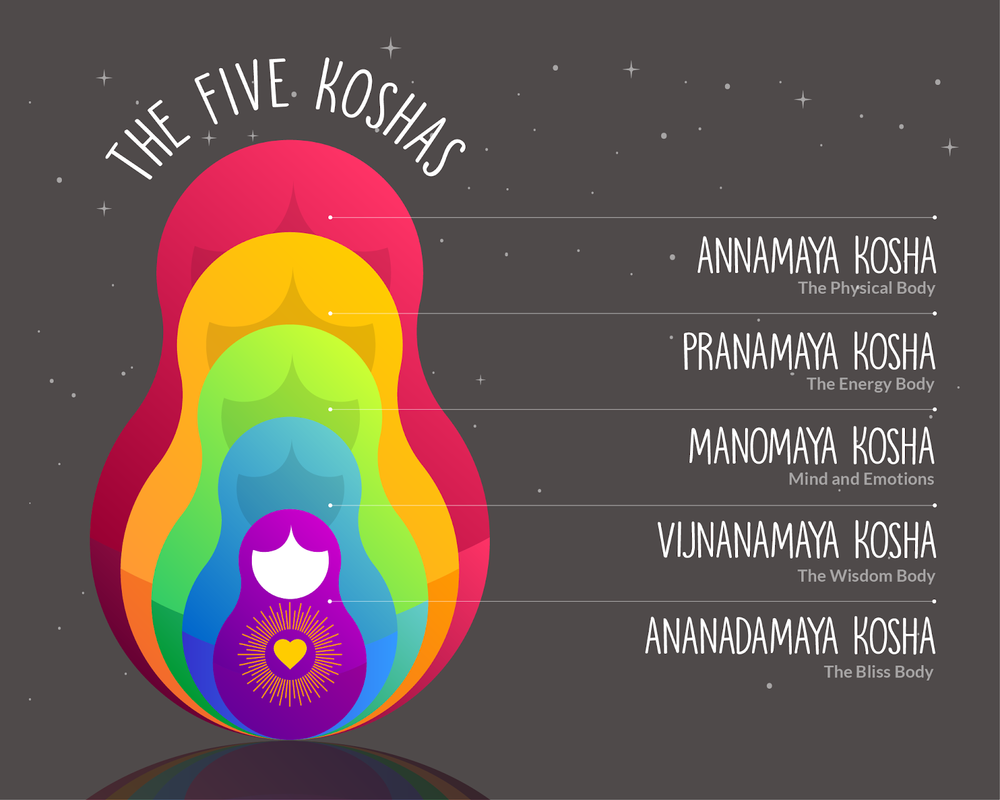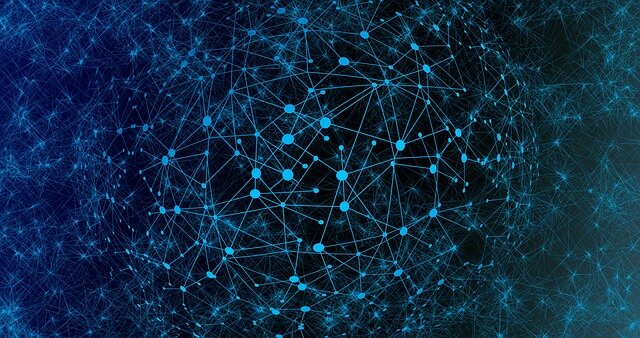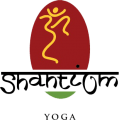The Koshas by Jenn Noble

The other day I was getting a massage when I started to feel like I was being shot up into the cosmos or something. I was in such a state of relaxation that I began to feel subtleties to bodily sensations I hadn’t noticed before, as well as an overall sense of wellbeing. I felt like I was in my body, but also observing my body outside of my myself with all the nuances of sensation, emotion, thought, etc.
I also noticed the pain I’d been experiencing for days due to a chronic spinal injury had subsided.
The next thought that came to mind was, “It’s the Koshas! I’m experiencing the Koshas!”.
What, you may be asking, are the Koshas? (You might also be asking what kind of massage I was getting, and I’ll share a little about that too!)
Well, are you familiar with the concept of Body/Mind/Spirit? It’s a way to look at yourself as a whole, beyond just the physical body. The Koshas are subsets of that.
Kosha loosely translates to “sheaths” in Sanskrit and can be found in the Upanishads, ancient Hindu texts that yoga strongly pulls from. They are said to be the layers of our being and are sometimes compared to Russian nesting dolls. You might also hear them described as vibrational fields or expressions of energy. There are five of them, and they can be powerful tools in understanding ourselves better, and finding balance and health.
You could spend lifetimes studying each of the Koshas, but let’s break them down in simple forms just to get started:

graphic from balanceyogalounge.com
Annamaya Kosha (physical body or anatomy) – Anna means “food” in Sanskrit. This is considered the densest layer of our being. It’s represented by our physical body. This is probably the layer most of us are familiar with, and the one western medicine tends to focus on when treating injury and illness. We can support this layer through our physical practices (like yoga asana), what we eat and our hygiene.
Pranamaya Kosha (energy body or physiology) – Prana means “energy” in Sanskrit. This term gets tossed around a lot in the yoga world, so you may have heard of it. In other traditions it might be called chi (or qi), aura, energy field, etc. It’s our life force – the thing that keeps our heart beating while we sleep and helps our cells communicate and support each other. We can connect and work with this layer through breath work (like pranayama in yoga), energy work, and also by eating foods full of prana (like fresh fruits and veggies).
Manomaya Kosha (mental body or psychology) – Mano means “mind” in Sanskrit. This is the layer that processes thoughts, feelings, memories and emotions. It’s responsible for the instinctive needs and desires of individuals. It’s related to ego, our sense of self and our will to move about the world and contextualize experiences. We can work with this kosha through intellectual pursuits, like studying sacred texts, psychological therapies, contemplation and meditation.
Vigyanamaya Kosha (wisdom body) – Vigyana means “knowing” in Sanskrit. It’s our true wisdom or higher awareness. It’s the part of us, that is us, that feels connected to the collective and sees the “bigger picture”. It is simply watching life unfold without the effects of thoughts and emotions clouding perspective. When we’re able to tap into this layer, we find deep wisdom on how to care for ourselves and for others. We can work with it through meditation, satsang (sacred, spiritual community gatherings) and service.
Anandamaya Kosha (bliss body or soul/spirit) – Ananda means “bliss” in Sanskrit. It is the layer of joy, peace, connection and love that is said to always be available to us. It’s not quite emotional, more like an expression of our truest nature. We access this when the “witness experience dissolves” (we remember we’re so much more than our bodies/thoughts/emotions and not separate from the world we reside in) and we are able to simply relax into the experience of life, no matter what’s happening.

It’s helpful to note these layers are not quite separate in a linear sense. You can study or focus on a specific Kosha, however they interact with one another and support one another. One way to experience this is to notice bodily sensation(s) that occur when you have a specific thought or feeling (Manomaya Kosha working with Annamaya Kosha).
I find this concept empowering because it means I have the ability to foster healing on many levels simply by what I’m focusing on. However I’m not responsible for having it all figured out. I trust that by working with one Kosha, the others are affected, which supports the whole-ness of my being.
That is exactly what happened during my massage.
I had been focusing on the structural injury of my spine and the effects it was having on my muscles, and the chronic pain it was causing. This was creating quite a bit of emotional stress in my life. When I spoke with my massage therapist about it, she suggested we include energy work to encourage the flow of prana and help relax my nervous system. The results were quite profound. By working with my Pranamaya Kosha, I was able to tap into Vigyanamaya Kosha which reminded me that I am so much more than this body I inhabit. The moment I started to experience that wisdom (Anandamaya Kosha), I was able to let go of my attachment to it and my physical pain dissipated.
I’m not going to sugar coat it and tell you the pain went away forever because it didn’t. I still have a chronic injury that presents various complications from time to time. However I now have a sense of ease to the way I’m working with it. I feel empowered instead of victimized because I’ve been reminded I have a choice on how I relate to this experience. I also know I have tools to lean on when things get really intense.
More importantly, I’m remembering (yet again) that I am so much more than this body I inhabit.
We all have a choice on how we relate to experiences. Sometimes it’s tough to remember that, but we do. Using the Koshas as a framework to look at those experiences can help.
I encourage you to be kind and patient with yourself as you work with this. For many of us this kind of thinking is foreign, so it’s going to take time for it to feel natural. Start simple and small. Choose one of the Koshas that really resonates with you and learn practices to tap into it even more. Treat it like a practice or a science experiment and see what happens.
Jenn teaches Vinyasa 1-2 at Shanti Om Yoga every Sunday 10:30 am. To find out more about Jenn Noble please visit her website Noble Yoga
